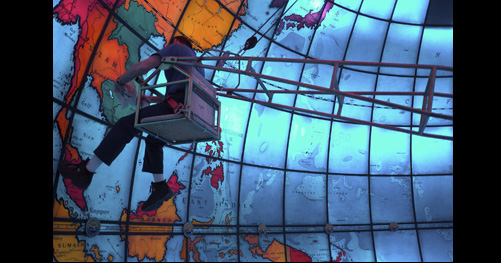Editor's Note
For Part I, see “Making the Mapparium.”
 Born in Boston as the Depression waned, the unique, hollowed-out globe room of the Mapparium mirrored the innovative spirit of Christian Scientists’ theological worldview. Spiritually and physically, Christian Scientists had broken new ground in American religion. Led by the charismatic, business-minded Mary Baker Eddy (1821-1910), they believed that homeopathic healing and prayer relieved physical suffering. Eddy’s central text, Science and Health with Key to the Scriptures (1875), galvanized Victorian Americans in search of cures beyond modern medicine. Eddy’s shrewd development of the denomination, which featured a church-run publishing empire, prescribed use of her works in tandem with the Bible.[i] Appealing to urban businessmen and middle to upper-class women through the language of Christian citizenship, Eddy outlined a new theological system nurtured by a “Mother-Father God.” In challenging mainstream ideas, Christian Science practitioners endured jeers at the “lady apostle.” They clung to their reform commitments, despite the biting criticism that they were merely caught “in the whirl of an Eddy.”[ii]
Born in Boston as the Depression waned, the unique, hollowed-out globe room of the Mapparium mirrored the innovative spirit of Christian Scientists’ theological worldview. Spiritually and physically, Christian Scientists had broken new ground in American religion. Led by the charismatic, business-minded Mary Baker Eddy (1821-1910), they believed that homeopathic healing and prayer relieved physical suffering. Eddy’s central text, Science and Health with Key to the Scriptures (1875), galvanized Victorian Americans in search of cures beyond modern medicine. Eddy’s shrewd development of the denomination, which featured a church-run publishing empire, prescribed use of her works in tandem with the Bible.[i] Appealing to urban businessmen and middle to upper-class women through the language of Christian citizenship, Eddy outlined a new theological system nurtured by a “Mother-Father God.” In challenging mainstream ideas, Christian Science practitioners endured jeers at the “lady apostle.” They clung to their reform commitments, despite the biting criticism that they were merely caught “in the whirl of an Eddy.”[ii]
The number of adherents steadily grew, even after Eddy’s death in 1910. Backed by a third generation of trustees, Christian Scientists turned to claiming their cultural “place” in Boston. A fleet of printing presses and bindery equipment sped off issues of The Christian Science Sentinel, Journal, Monitor, and more. By 1933, Christian Scientists’ theology, church life, and literature looked strikingly different than that of their Protestant peers. What could a map do for the Church’s mission? Geography, as the Mapparium’s chief architect Chester Churchill had promised, was a “simple, direct manner” of conveying the Church’s global spread, an idea that fit neatly with the expansion of Christian Science into American culture. His Mapparium synthesized religious respect for divine creation with the organization’s more worldly aims.
 The Mapparium’s 608 panels were “easily” removable to accommodate new countries, but Christian Science directors have never approved a revised edition. Rather, the Mapparium was claimed as a copyrighted work of art in 1966. As the 20th century waned, visitors still praised the map’s artistry. They were increasingly critical, though, of the map’s geographical nostalgia. Eyeing stale designations like “Italian East Africa” and “Siam” reminded readers that the past is, actually, a foreign country.
The Mapparium’s 608 panels were “easily” removable to accommodate new countries, but Christian Science directors have never approved a revised edition. Rather, the Mapparium was claimed as a copyrighted work of art in 1966. As the 20th century waned, visitors still praised the map’s artistry. They were increasingly critical, though, of the map’s geographical nostalgia. Eyeing stale designations like “Italian East Africa” and “Siam” reminded readers that the past is, actually, a foreign country.
The Church listened. A four-year renovation, begun in 1998, restored physical aspects of the site but preserved its 1930s world geography. Church historians supplied a new key to the map, in the form of a 7-minute audiovisual show introducing “a world that no longer exists.” Here’s the Christian Science offer: Become an author of the map by identifying routes of revision. In this way, the Mapparium retains much of the makers’ original intent: to unite Christian Scientists and newcomers in crafting a better world.
Let’s close with the craftsman’s view. For Dutch émigré Albert Nyland, making the Mapparium likely held a special dimension akin to the devotional impulse that medieval cartographers cultivated when they created mappaemundi. Nyland (ca. 1881-1963), a china painter, came to New Jersey in the 1920s with a family of seven. He struggled to find artisanal work during the Depression.[iii] A sudden and very specific offer from architect Chester Churchill—to achieve the crucial uniformity of color between the Mapparium’s stained glass plates—eased the Nylands’ woes. Two younger sons, Howard and Edward, recounted how “warmly” and memorably the Christian Science community greeted their father, one of the map’s many makers, when he saw the finished room decades later. The Mapparium marked Albert Nyland’s only known commission in stained glass, making it yet another kind of religious artifact. “The whole family,” as the craftsman’s sons recalled, “felt that the commission was from the hand of God.”[iv]
[i] Thanks to Raymond J. Haberski, David W. Mislin, and Rachel Gordan for helping me think through this topic during our panel at the S-USIH 2017 annual meeting in Plano, Texas.
Mary Baker Eddy, Manual of the Mother Church, 89th ed. (Boston: The First Church of Christ, Scientist, 1908), 58.
[ii] Raymond J. Cunningham, “The Impact of Christian Science on the American Churches, 1880-1910,” The American Historical Review
72 (1967): 885-905.
[iii] Stephen R. Howard, summary of oral history interview with Howard and Edward Nyland, Organizational Records.
[iv] Ibid.

0